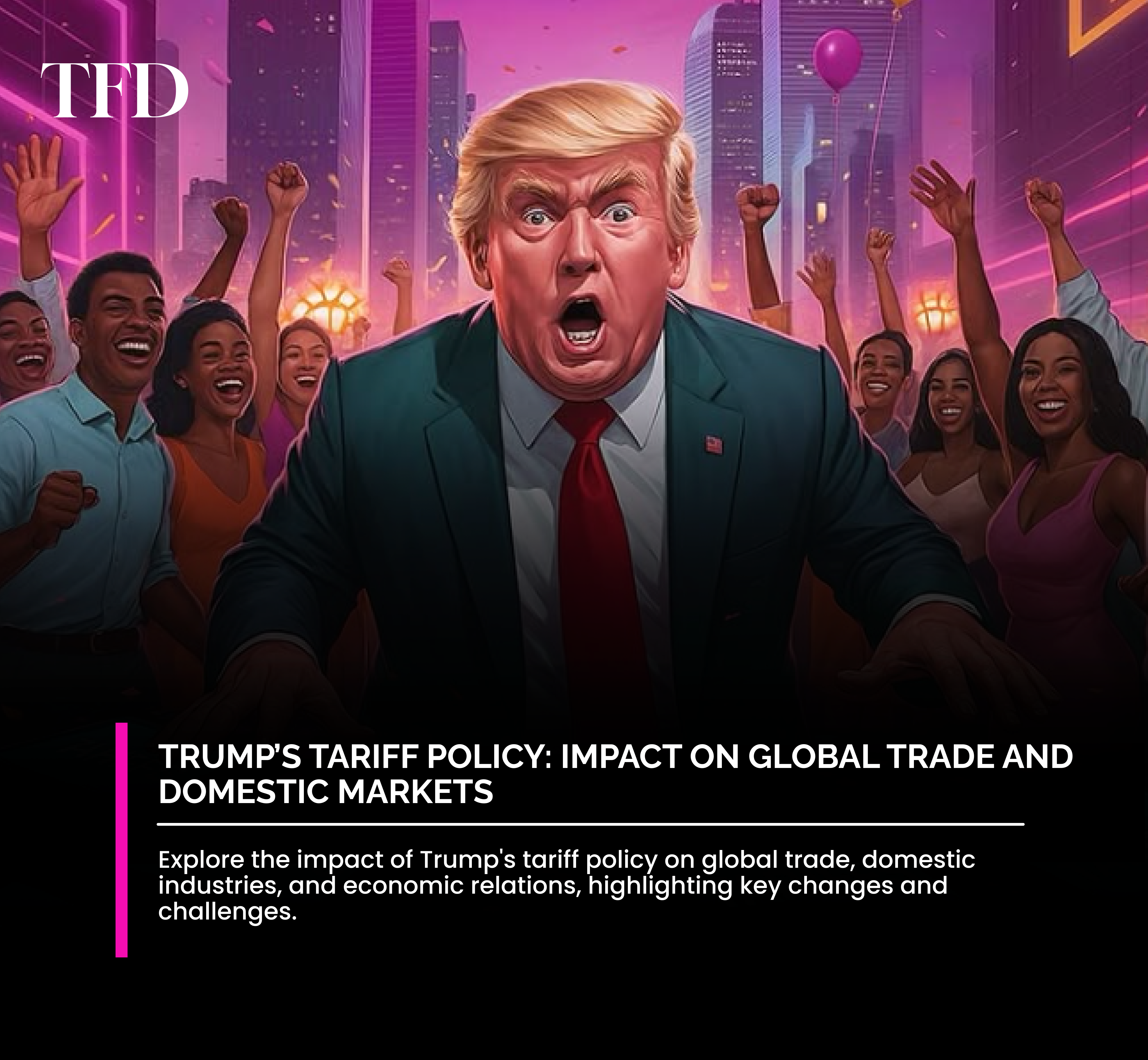Former U.S. President Donald Trump’s administration introduced significant changes to the global trade landscape, with tariffs playing a central role. These trade policies, often controversial and disruptive, had far-reaching effects on both global markets and domestic industries. This article explores how Trump’s tariff policy impacted global trade relations and the U.S. economy, offering an in-depth look at the direct consequences on markets, industries, and geopolitical alliances.
Introduction
When Donald Trump took office in January 2017, his administration quickly set a bold course in global trade. At the core of this strategy was the imposition of tariffs on foreign goods. Trump’s “America First” approach aimed to reduce the trade deficit, protect U.S. manufacturing, and boost domestic employment. However, while tariffs were intended to secure these objectives, they also brought about significant economic disruptions and diplomatic challenges. Understanding the long-term impact of these tariffs is crucial to grasping the shifts in global trade dynamics and their effect on U.S. businesses and consumers.
What Is Trump’s Tariff Policy?
Trump’s tariff policy was based on the idea that the U.S. was being taken advantage of by its trading partners, particularly China. The administration sought to renegotiate trade deals that they deemed unfavorable and imposed tariffs as leverage to get better terms. The policy focused primarily on protecting American jobs and industries that were seen as vulnerable to foreign competition.
Key elements of Trump’s tariff policy included:
- Imposing tariffs on China: One of the most high-profile aspects of the Trump administration’s trade policy was the imposition of tariffs on Chinese imports, aimed at addressing trade imbalances and intellectual property theft.
- Revised NAFTA: Trump’s administration replaced the North American Free Trade Agreement (NAFTA) with the United States-Mexico-Canada Agreement (USMCA), which included new provisions on tariffs and trade.
- Targeted tariffs on steel and aluminum: To protect American manufacturing, Trump imposed tariffs on imported steel and aluminum, which affected many countries, including major U.S. allies.
- Withdrawal from the Trans-Pacific Partnership (TPP): Trump pulled the U.S. out of the TPP, a multilateral trade agreement, citing its unfavorable terms for American workers.
These policy changes led to dramatic shifts in the way global trade occurred, impacting not only international relations but also industries across the U.S.
Impact on Global Trade
Rising Trade Tensions
Trump’s tariff policies were widely seen as a catalyst for escalating trade tensions around the world. The imposition of tariffs led to retaliatory actions by countries affected by these tariffs. China, for instance, responded with tariffs on American goods, particularly agricultural products, which caused harm to U.S. farmers. Similarly, the European Union, Canada, and Mexico retaliated against the U.S. steel and aluminum tariffs.
These trade wars disrupted global supply chains, increased uncertainty in international markets, and led to reduced global trade volumes. The increase in tariffs made goods more expensive, which in turn affected global demand for both imported and exported products.
Shifts in Global Trade Partnerships
One of the most significant consequences of Trump’s tariff policies was the shifting of global trade partnerships. Countries and regions began seeking new trade agreements that would either bypass the U.S. or reduce their dependency on American markets. For example, China signed a major trade agreement with the European Union, and many countries within the Asia-Pacific region moved forward with trade agreements like the Comprehensive and Progressive Agreement for Trans-Pacific Partnership (CPTPP).
While the U.S. maintained its position as a dominant force in global trade, these shifts illustrated the vulnerabilities and challenges the Trump administration’s tariffs posed to U.S. influence in the international trade system.
Impact on Domestic Markets
Price Increases for U.S. Consumers
One of the immediate effects of Trump’s tariff policy on domestic markets was an increase in the prices of consumer goods. Tariffs were often passed down to U.S. consumers in the form of higher prices for everyday items. From electronics to clothing and food, consumers experienced higher costs due to tariffs on imported goods.
For example, the tariffs on Chinese-made electronics and consumer goods significantly impacted companies like Apple, which faced higher production costs. In many cases, U.S. companies that sourced materials or products from overseas were forced to either absorb the additional costs or raise their prices, leading to inflationary pressures in the economy.
Impact on U.S. Manufacturing
While the tariffs aimed to protect American manufacturing, the outcomes were mixed. Some industries, like steel and aluminum, saw a temporary boost due to the higher costs of foreign competition. However, many other sectors that depended on global supply chains suffered. U.S. manufacturers faced increased production costs for raw materials, which led to reduced competitiveness in the global market.
Furthermore, many U.S. companies faced difficulties finding alternative suppliers, particularly for specialized components that were no longer available at competitive prices due to tariffs.
Job Losses and Gains in Various Sectors
The effects of Trump’s tariffs on employment were similarly complex. While certain industries like steel and manufacturing saw job gains, many others suffered losses due to the increased cost of imported goods and the retaliatory tariffs placed on U.S. exports. U.S. farmers, for example, suffered heavily as China imposed tariffs on American agricultural products. According to estimates, U.S. agricultural exports fell by billions of dollars due to these trade restrictions.
On the other hand, industries focused on domestic production benefited in some cases. For example, American steel producers saw an uptick in demand, leading to job creation in the steel industry.
Global Economic Uncertainty
Trump’s tariff policy contributed to heightened global economic uncertainty. Businesses that relied on international trade found themselves navigating an increasingly complex landscape of tariffs and trade restrictions. This uncertainty was compounded by the changing dynamics in trade agreements, such as the USMCA, which introduced new regulations and requirements for businesses operating in North America.
While uncertainty can be a motivator for some businesses to seek new opportunities and diversify their markets, it also led to a slowdown in investment in industries that were most vulnerable to trade restrictions. Overall, global economic growth was affected as businesses adjusted to the changing trade environment.
Long-Term Effects on Trade Policy
The long-term effects of Trump’s tariff policy remain a subject of debate. Some argue that the policy was successful in achieving its goal of reducing the U.S. Trade deficit, while others contend that the negative impacts on global trade and domestic markets outweighed the benefits. As global trade relationships evolve and new trade agreements are negotiated. The legacy of Trump’s tariffs will continue to shape U.S. foreign policy and global trade dynamics.
FAQs
What were the key goals of Trump’s tariff policy?
Trump’s tariff policy was primarily aimed at reducing the U.S. trade deficit, protecting American jobs, and ensuring fairer trade relationships with countries like China.
How did tariffs impact U.S. consumers?
Tariffs led to higher prices for many imported goods, including electronics, clothing, and household products, ultimately raising costs for U.S. consumers.
Did Trump’s tariffs help American manufacturing?
In some sectors, such as steel, tariffs did provide short-term protection for American manufacturing. However, other industries faced higher input costs, which made it harder to compete globally.
How did Trump’s tariff policy affect global trade?
Trump’s tariffs led to increased trade tensions. With many countries retaliating with their own tariffs, which disrupted global supply chains and reduced international trade volumes.
What sectors in the U.S. economy benefited from the tariffs?
Sectors like steel and aluminum saw job growth due to the protectionist tariffs, as U.S. producers became more competitive in the domestic market.
What are the long-term impacts of Trump’s tariff policy?
While some of the long-term impacts are still being evaluated, the tariffs created significant disruptions in global trade and had mixed effects on U.S. industries, leading to shifts in trade relationships and supply chains.
Conclusion
Trump’s tariff policy undeniably reshaped global trade and had significant repercussions for both U.S. and international markets. The policy aimed to revitalize American industries and reduce trade imbalances. But often led to economic disruptions and strained diplomatic relations. While some sectors benefited, others, particularly agriculture and those dependent on global supply chains, faced challenges. As global trade continues to evolve, the legacy of Trump’s tariff policy will be a key consideration for future trade negotiations and economic strategies.
Also read: The Last of Us Season 2: Release Date, Streaming Options, Episode Guide, and More











